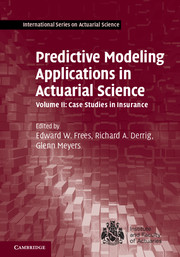Book contents
- Frontmatter
- Contents
- Contributors
- Preface
- Acknowledgments
- 1 Pure Premium Modeling Using Generalized Linear Models
- 2 Applying Generalized Linear Models to Insurance Data: Frequency/Severity versus Pure Premium Modeling
- 3 Generalized Linear Models as Predictive Claim Models
- 4 Frameworks for General Insurance Ratemaking: Beyond the Generalized Linear Model
- 5 Using Multilevel Modeling for Group Health Insurance Ratemaking: A Case Study from the Egyptian Market
- 6 Clustering in General Insurance Pricing
- 7 Application of Two Unsupervised Learning Techniques to Questionable Claims: PRIDIT and Random Forest
- 8 The Predictive Distribution of Loss Reserve Estimates over a Finite Time Horizon
- 9 Finite Mixture Model and Workers’ Compensation Large-Loss Regression Mixture Model and Workers’ Compensation Large-Loss Regression Analysis
- 10 A Framework for Managing Claim Escalation Using Predictive Modeling
- 11 Predictive Modeling for Usage-Based Auto Insurance
- Index
- References
8 - The Predictive Distribution of Loss Reserve Estimates over a Finite Time Horizon
Published online by Cambridge University Press: 05 August 2016
- Frontmatter
- Contents
- Contributors
- Preface
- Acknowledgments
- 1 Pure Premium Modeling Using Generalized Linear Models
- 2 Applying Generalized Linear Models to Insurance Data: Frequency/Severity versus Pure Premium Modeling
- 3 Generalized Linear Models as Predictive Claim Models
- 4 Frameworks for General Insurance Ratemaking: Beyond the Generalized Linear Model
- 5 Using Multilevel Modeling for Group Health Insurance Ratemaking: A Case Study from the Egyptian Market
- 6 Clustering in General Insurance Pricing
- 7 Application of Two Unsupervised Learning Techniques to Questionable Claims: PRIDIT and Random Forest
- 8 The Predictive Distribution of Loss Reserve Estimates over a Finite Time Horizon
- 9 Finite Mixture Model and Workers’ Compensation Large-Loss Regression Mixture Model and Workers’ Compensation Large-Loss Regression Analysis
- 10 A Framework for Managing Claim Escalation Using Predictive Modeling
- 11 Predictive Modeling for Usage-Based Auto Insurance
- Index
- References
Summary
Chapter Preview. This chapter shows how to take the output of a Bayesian MCMC stochastic loss reserve model and calculate the predictive distribution of the estimates of the expected loss over a finite time horizon. Then given a 99.5% VaR regulatory capital requirement, it shows how to calculate the regulatory capital for a one-, two-, and three-year time horizon.
As an insurer gathers more data on its loss development in subsequent calendar years, this chapter finds that in most cases, it can release capital to its investors over time. But in other cases it will have to add capital in subsequent years. In keeping with the 99.5% VaR criterion, it finds that for many insurers, this additional capital can be substantial. As capital becomes more expensive to the stressed insurer, it might be prudent capital management for an insurer to voluntarily raise that capital in advance. This chapter shows one way to calculate the amount of voluntary capital that will be needed to satisfy the 99.5% VaR requirement for the next calendar year.
Introduction
In Meyers (2015) I applied Bayesian Markov chain Monte Carlo (MCMC) models to stochastic loss reserving problems. The goal there was to predict the distribution of outcomes after ten years of development. The focus of that monograph was to test how well those models predicted the distribution of outcomes on a large number of loss development triangles that are reported in Schedule P of the National Association of Insurance Commissioners (NAIC) annual statements. The monograph identifies two models, the correlated chain ladder (CCL) model and the changing settlement rate (CSR) models as the best performers on incurred loss triangles and paid loss triangles, respectively. This chapter will focus on the CCL model on incurred loss triangles.
While the time frame of 10 years of development is good for testing models, operationally it is of little use. Insurance executives and regulators have a much shorter time frame. We see evidence of that concern in the 99.5% value of risk (VaR) over a one-year time horizon specified by Solvency II for calculating the amount of capital to support the loss reserve liability. One rationale for the one-year time frame that I heard was that insurers have the opportunity make adjustments as time passes.
- Type
- Chapter
- Information
- Predictive Modeling Applications in Actuarial Science , pp. 208 - 223Publisher: Cambridge University PressPrint publication year: 2016

